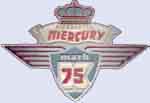British Anzanis came from the UK with some variations of heads for their A and B displacement engines. One style of head's combustion chamber was the classic "bell" capped hemi style head with the combustion chamber centered equally around the diameter of the bore size tapering upward to the spark plug hole making it a classic 8 to 1 compression ratio for gasoline oil use as a stock racing motor. This style of cylinder head is common place with most loop scavenged 2 stroke gasoline engines today but Anzanis came out with them priort to 1960 with the loop scavenging. This cylinder head was seated on top of a composite multi layered type head gasket well suited for gasoline use but was found to be unsuitable for higher compressions where Methanol and Nitro were used.
The cylinder head for Alky racing used a combustion chamber with an offset squish feature to it that would raise the air fuel charge accross the lower part of the head to where it would squish the air fuel off to one side into the combustion chamber proper. Compression with these heads depending on machined thickness could be varied from 12 - 14 to 1. Composite head gaskets proved to immediately to leak badly. Bill Tenney's standard adice was to custom make sheet copper and in cases alminum single layer head gaskets that would then be head gasket glue coated and torqued down with the standard BSW head bolts. Leakage was pretty much eliminated where nitro percentages in fuel did not exceed 15%.
On the North West Jim Hallum and his associates pretty much used a whole lot more Nitro than down east so their approach to Anzani cylinder heads turned out quite different. They were using upward from 25% to over 30% nitro'd methanol based racing fuels. They too initially started out with using the revised sheet copper head gaskets to stop compression leakage associated with Alky/Nitro fuels. They soon found that using more nitro exceeding 15% produced head gasket leakage on both sides of the copper head gasket. To remove the source of the leakage from one side or both sides of the copper head gasket they dispensed with the head gasket itself altogether by careful machining of head surfaces and also using a specialized heat proof proprietary alumina joint cement that when the head was placed on the block it seemed that it could have run without headbolts because the glue set so tight. But, in reality head bolts were necessary and installed and the head to block joint did not leak.
Still not completely satisfied with the distance between the headbolts having adequate torque evenly spead over the head and block matting surfaces, Jim Hallum removed the casting plugs that closed off the water jacket openings to the head, threaded in a steel insert into each casting plug and installed a pressurizing capbolt that forced the inside of the heads water jacket side of the casting downward to the engine head. Process one became torquing the head down glued at the mating surfaces with its 6 main head bolts and process 2 was to torque down 4 capbolts through the casting plug adapters that served to spread the torque more evenly on the cylinder head to block joint surfaces more evenly ensuring no leakage ever occurred as a possibility and none did.
The engine had a kind of not installed bolts look to it, but it worked well. These head bolt and joint cement improvements did not find their way East to Bill Tenney no different than the Tenney modified to 6 intake port loop engine blocks then too untilizing 25%+ nitro'e methanol fuels never found their way to the Nort West, but they are another story that involves the North West's evolution of the "T" type exhaust ports.


 Thanks:
Thanks:  Likes:
Likes: 






Bookmarks